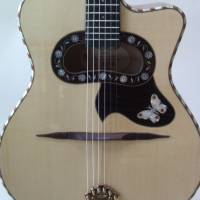DjangoBooks.com
Welcome to our Community!
Categories
- 20K All Categories
- 1.1K General
- 476 Welcome
- 59 Archtop Eddy's Corner
- 146 CD, DVD, and Concert Reviews
- 385 FAQ
- 26 Gypsy Jazz Italia
- 27 Photos
- 202 Gypsy Picking
- 21 Unaccompanied Django
- 15 Pearl Django Play-Along Vol.1
- 17 Gypsy Fire
- 45 Gypsy Rhythm
- 1.4K Gypsy Jazz University - Get Educated
- 131 Gypsy Jazz 101
- 227 Repertoire
- 219 History
- 708 Technique
- 51 Licks and Patterns
- 6 Daniel Givone Manouche Guitare Method Users Group
- 20 Eddie Lang Club
- 1.3K Gypsy Jazz Gear
- 802 Guitars, Strings, Picks, Amps, Pickups and Other Accessories
- 460 Classifieds
- 49 Recording
- 62 Other Instruments
- 18 Violin
- 5 Mandolin
- 22 Accordion
- 7 Bass
- 10 Woodwinds
- 348 Gypsy Jazz Events
- 143 North America
- 110 Europe
- 95 International
In this Discussion
Shims - how to size?
 constantine
New York✭✭✭✭ Geronimo Mateos
constantine
New York✭✭✭✭ Geronimo Mateos
Hi I need to shim my bridge..should the shim be the size of the bridge foot or some other dimension?
What is the highest a shim should be , like 2.0 mm?
thanks - Dean
What is the highest a shim should be , like 2.0 mm?
thanks - Dean











Comments
I then glue the shims to the bridge feet using Titebond and masking tape to get a bit of pressure on the join. Once it's dried I trim off the excess so it's all flush with the sides of the bridge and then file the ends and cut back any excess from the inside of the feet.
Then you can sand the shims down a bit if needed and - if it's a new bridge - cut string slots ( hence the 1mm over I mentioned earlier ). You can of course do it without gluing the shims but if you're pretty happy with the height I just think you're as well to glue it all together for structural integrity.
Cheers, good luck
Alan
Whether glued or not, a good fit is the main thing. If the original bridge fit the top well and the shim surfaces are perfectly parallel, no problem. But if in the end, the bridge doesn't fit the top perfectly, all kinds of problems ensue: Bad overtones, reduced volume, thin tone, etc. If you have to refit the bridge, then gluing the shims is probably the better option as it can be next to impossible to fine tune a shim.
CB
"It's a great feeling to be dealing with material which is better than yourself, that you know you can never live up to."
-- Orson Welles